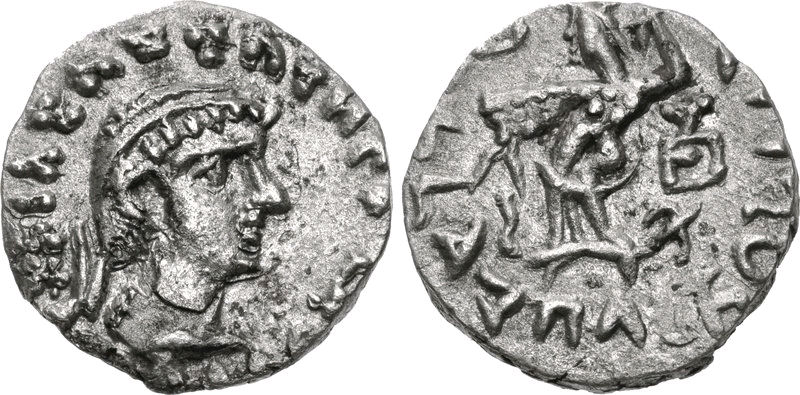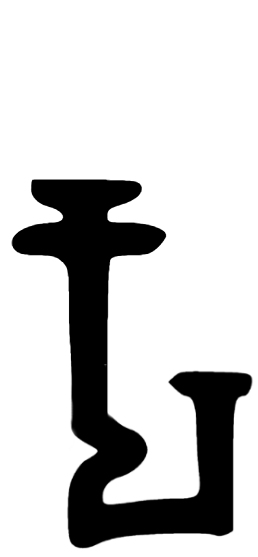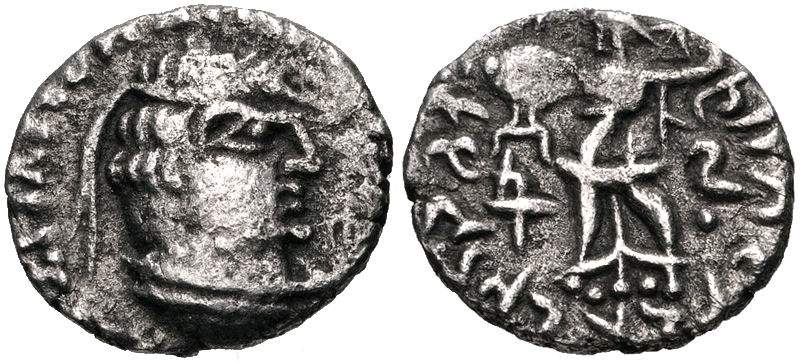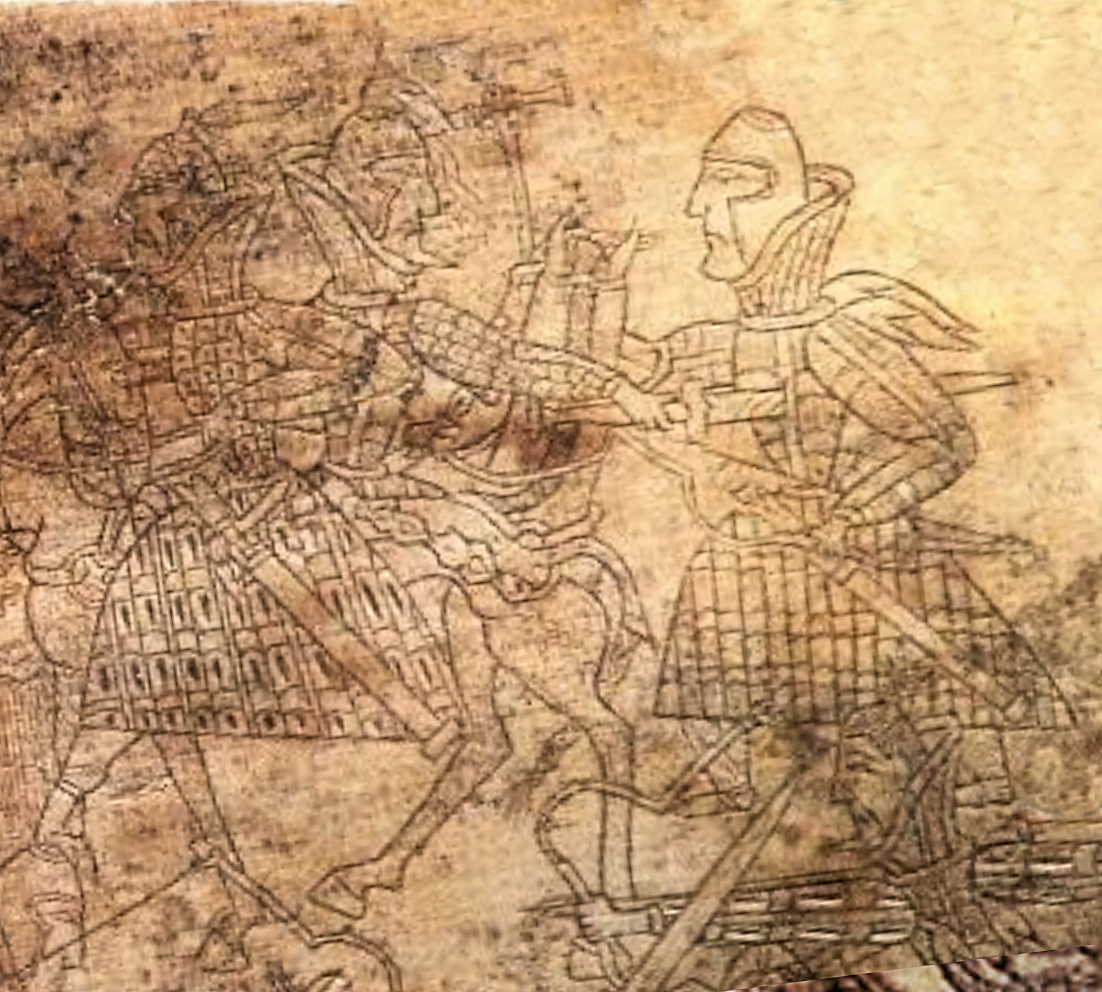|
Bhadayasa
Bhadayasa, also Bhadrayasha ( Kharosthi: , ), was a minor Indo-Scythian ruler in the areas of Eastern Punjab and Mathura in India, during the 1st century CE. He is considered one of the Northern Satraps. He is mainly known through his coins, which are direct imitations of those of the Indo-Greek king Zoilos II, or the hypothetical Zoilos III. Bhadayasa is generally considered a successor of Rajuvula in the Eastern Punjab. However, since his coinage is copied from Zoilos II or Zoilos III rather than the later Strato II or Strato III (whom Rajuvula imitated), Jakobsson places Bhadayasa before the rule of these last kings, around 35 BCE.J. Jakobsson, ÔA Possible New Indo-Greek King Zoilos III, and an Analysis of Realism on Indo-Greek Royal PortraitsÇŁ NC 170 (2010), pp. 38 At around the same time, the Indo-Scythian ruler Sodasa, son of Rajuvula, ruled in Mathura Mathura () is a city and the administrative headquarters of Mathura district in the Indian state of Utta ... [...More Info...] [...Related Items...] OR: [Wikipedia] [Google] [Baidu] |
Bhadrayasha Coin
Bhadayasa, also Bhadrayasha (Kharosthi: , ), was a minor Indo-Scythian ruler in the areas of Punjab, India, Eastern Punjab and Mathura, Uttar Pradesh, Mathura in India, during the 1st century CE. He is considered one of the Northern Satraps. He is mainly known through his coins, which are direct imitations of those of the Indo-Greek king Zoilos II, or the hypothetical Zoilos III. Bhadayasa is generally considered a successor of Rajuvula in the Punjab, India, Eastern Punjab. However, since his coinage is copied from Zoilos II or Zoilos III rather than the later Strato II or Strato III (whom Rajuvula imitated), Jakobsson places Bhadayasa before the rule of these last kings, around 35 BCE.J. Jakobsson, ÔA Possible New Indo-Greek King Zoilos III, and an Analysis of Realism on Indo-Greek Royal PortraitsÇŁ NC 170 (2010), pp. 38 At around the same time, the Indo-Scythian ruler Sodasa, son of Rajuvula, ruled in Mathura. Notes Indo-Scythian kings 1st-century Indian monarchs ... [...More Info...] [...Related Items...] OR: [Wikipedia] [Google] [Baidu] |
Northern Satrap
The Northern Satraps (Brahmi: , ''Kß╣úatrapa'', "Satraps" or , ''Mahakß╣úatrapa'', "Great Satraps"), or sometimes Satraps of Mathura, or Northern Sakas, are a dynasty of Indo-Scythian rulers who held sway over the area of Eastern Punjab and Mathura after the decline of the Indo-Greeks, from the end of the 1st century BCE to the 2nd century CE. They are called "Northern Satraps" in modern historiography to differentiate them from the "Western Satraps", who ruled in Gujarat and Malwa at roughly the same time and until the 4th century CE. They are thought to have replaced the last of the Indo-Greek kings in the Eastern Punjab, as well as the Mitra dynasty and the Datta dynasty of local Indian rulers in Mathura. The Northern Satraps were probably displaced by, or became vassals of, the Kushans from the time of Vima Kadphises, who is known to have ruled in Mathura in 90ÔÇô100 CE, and they are known to have acted as Satraps and Great Satraps in the Mathura region for his successor Kan ... [...More Info...] [...Related Items...] OR: [Wikipedia] [Google] [Baidu] |
Northern Satraps
The Northern Satraps (Brahmi: , ''Kß╣úatrapa'', "Satraps" or , ''Mahakß╣úatrapa'', "Great Satraps"), or sometimes Satraps of Mathura, or Northern Sakas, are a dynasty of Indo-Scythian rulers who held sway over the area of Eastern Punjab and Mathura after the decline of the Indo-Greeks, from the end of the 1st century BCE to the 2nd century CE. They are called "Northern Satraps" in modern historiography to differentiate them from the "Western Satraps", who ruled in Gujarat and Malwa at roughly the same time and until the 4th century CE. They are thought to have replaced the last of the Indo-Greek kings in the Eastern Punjab, as well as the Mitra dynasty and the Datta dynasty of local Indian rulers in Mathura. The Northern Satraps were probably displaced by, or became vassals of, the Kushans from the time of Vima Kadphises, who is known to have ruled in Mathura in 90ÔÇô100 CE, and they are known to have acted as Satraps and Great Satraps in the Mathura region for his successor Kan ... [...More Info...] [...Related Items...] OR: [Wikipedia] [Google] [Baidu] |
Zoilos III
Zoilus II Soter ( grc, ╬ľ¤ë╬É╬╗╬┐¤é ╬ú¤ë¤ä╬«¤ü, Z┼Ź├»los S┼Źt─ôr; epithet means "the Saviour") was an Indo-Greek king who ruled in eastern Punjab. Bopearachchi dates his reign to c. 55–35 BC, a date approximately supported by R. C. Senior. It is possible that some of his coins were issued by a separate king, Zoilus III. Rule Zoilus seems to have been one of the rulers who succeeded the last important Indo-Greek king Apollodotus II in the eastern parts of his former kingdom. All these kings use the same symbol as Apollodotus II, the fighting Pallas Athene introduced by Menander I, and usually also the same epithet ''Soter'' (Saviour). It is therefore possible that they belonged to the same dynasty, and Zoilus II could also have been related to the earlier king Zoilus I, but the lack of written sources make all such conjections uncertain. He may have been the Bactrian ally of Mark Antony and Cleopatra VII referred to by Virgil in his vision of the Battle of Actium in : ... [...More Info...] [...Related Items...] OR: [Wikipedia] [Google] [Baidu] |
Zoilos II
Zoilus II Soter ( grc, ╬ľ¤ë╬É╬╗╬┐¤é ╬ú¤ë¤ä╬«¤ü, Z┼Ź├»los S┼Źt─ôr; epithet means "the Saviour") was an Indo-Greek king who ruled in eastern Punjab. Bopearachchi dates his reign to c. 55–35 BC, a date approximately supported by R. C. Senior. It is possible that some of his coins were issued by a separate king, Zoilus III. Rule Zoilus seems to have been one of the rulers who succeeded the last important Indo-Greek king Apollodotus II in the eastern parts of his former kingdom. All these kings use the same symbol as Apollodotus II, the fighting Pallas Athene introduced by Menander I, and usually also the same epithet ''Soter'' (Saviour). It is therefore possible that they belonged to the same dynasty, and Zoilus II could also have been related to the earlier king Zoilus I, but the lack of written sources make all such conjections uncertain. He may have been the Bactrian ally of Mark Antony and Cleopatra VII referred to by Virgil in his vision of the Battle of Actium in : ... [...More Info...] [...Related Items...] OR: [Wikipedia] [Google] [Baidu] |
Strato II
Strato II Soter ( grc, ╬ú¤ä¤ü╬Ȥä¤ë╬Ż B╬ä ߯ü ╬ú¤ë¤ä╬«¤ü, ''Str├ít┼Źn B╬ä ho SotߪŚr''; epithet means "the Saviour") also known as Stratha, was an Indo-Greek king. He ruled c. 25 BCE to 10 CE according to Bopearachchi. R. C. Senior suggests that his reign ended perhaps a decade earlier. He may have been supplanted by the Indo-Scythian Northern Satraps, particularly Rajuvula and Bhadayasa, whose coins were often copied on those of the last Indo-Greek kings.The Dynastic Arts of the Kushans, John M. Rosenfield, University of California Press, 1967, p.13/ref> Numerous coins of Rajuvula have been found in company with the coins of the Strato group in the Punjab, India, Eastern Punjab (to the east of the Jhelum) and also in the Mathura area: for example, 96 coins of Strato II were found in Mathura in conjunction with coins of Rajuvula, who also imitated the designs of Strato II in the majority of his issues. Rule Strato II ruled in the eastern Punjab, probably retaining the capi ... [...More Info...] [...Related Items...] OR: [Wikipedia] [Google] [Baidu] |
Indo-Scythian
Indo-Scythians (also called Indo-Sakas) were a group of nomadic Iranian peoples of Scythian origin who migrated from Central Asia southward into modern day Pakistan and Northwestern India from the middle of the 2nd century BCE to the 4th century CE. The first Saka king of India was Maues/Moga (1st century BCE) who established Saka power in Gandhara, Pakistan and the Indus Valley. The Indo-Scythians extended their supremacy over north-western India, conquering the Indo-Greeks and other local kingdoms. The Indo-Scythians were apparently subjugated by the Kushan Empire, by either Kujula Kadphises or Kanishka. Yet the Saka continued to govern as satrapies, forming the Northern Satraps and Western Satraps. The power of the Saka rulers started to decline in the 2nd century CE after the Indo-Scythians were defeated by the Satavahana emperor Gautamiputra Satakarni. Indo-Scythian rule in the northwestern Indian subcontinent ceased when the last Western Satrap Rudrasimha III was defeated ... [...More Info...] [...Related Items...] OR: [Wikipedia] [Google] [Baidu] |
Indo-Greek
The Indo-Greek Kingdom, or Graeco-Indian Kingdom, also known historically as the Yavana Kingdom (Yavanarajya), was a Hellenistic period, Hellenistic-era Ancient Greece, Greek kingdom covering various parts of Afghanistan and the northwestern regions of the Indian subcontinent (parts of modern-day Pakistan and northwestern India). This kingdom was in existence from ca. 200 BC to ca. 1 BC. During its existence the kingdom was ruled over by 30 successive kings. Menander I, being the most well known amongst the Indo-Greek kings, is often referred to simply as ''ÔÇťMenander,ÔÇŁ'' despite the fact that there was indeed another Indo-Greek King known as Menander II. Menander I's capital was at Sagala in the Punjab region, Punjab (present-day Sialkot). The kingdom was founded when the Graeco-Bactrian king Demetrius I of Bactria, Demetrius (and later Eucratides I, Eucratides) invaded India from Bactria in 200 BC. The Greeks in the Indian Subcontinent were eventually divided from the G ... [...More Info...] [...Related Items...] OR: [Wikipedia] [Google] [Baidu] |
Strato III
Strato III Philopator ( el, ╬ú¤ä¤ü╬Ȥä¤ë╬Ż ╬ô╬ä ╬Ž╬╣╬╗╬┐¤Ç╬Ȥä¤ë¤ü; epither means "the Father-loving") was an Indo-Greek king who ruled c. 25 BCE to 10 CE. He is only known through the joint coins with his father Strato II. He may have been supplanted, in conjunction with his father or later as an independent king, by the Indo-Scythian Northern Satraps, particularly Rajuvula and Bhadayasa, whose coins were often copied. Strato was the last of the line of Diodotus and independent Hellenistic king to rule at his death in 10 AD.The Dynastic Arts of the Kushans, John M. Rosenfield, University of California Press, 1967, p.13/ref> Coinage Strato III may also have issued coins on his own, but these are rare and unconfirmed. A few silver coins with a different portrait and the inscription Strato Soter ''Dikaios'' ("the just") may also belong to Strato III as sole ruler, or to a fourth king named Strato.Senior, ibid. Just like the earlier king Strato I, Strato III is thought to belon ... [...More Info...] [...Related Items...] OR: [Wikipedia] [Google] [Baidu] |
Sodasa
Sodasa (Kharosthi: , ; Middle Brahmi script: , , also , ) was an Indo-Scythian Northern Satrap and ruler of Mathura during the later part of the 1st century BCE or the early part of 1st century CE. He was the son of Rajuvula, the Great Satrap of the region from Taxila to Mathura. He is mentioned in the Mathura lion capital. Name Sodasa's name is recorded in Kharosthi as () and in Brahmi as () and (), which are derived from the Saka name , meaning "who kept the good acts in memory". Rule Sodasa reigned during the 1st century CE, and also took the title of Great Satrap at one point, probably in the area of Mathura as well, but possibly under the suzerainty of the Indo-Parthian king Gondophares. At the same time the Indo-Scythian Bhadayasa ruled in the eastern Punjab. There were numerous cultural and political exchanges between the Indo-Scythians of the northwest and those of Mathura. Sodasa may have been a contemporary of the Western Kshatrapa Nahapana and the Indo-Parthi ... [...More Info...] [...Related Items...] OR: [Wikipedia] [Google] [Baidu] |
Indo-Scythian Kings
Indo-Scythians (also called Indo-Sakas) were a group of nomadic Iranian peoples of Scythian origin who migrated from Central Asia southward into modern day Pakistan and Northwestern India from the middle of the 2nd century BCE to the 4th century CE. The first Saka king of India was Maues/Moga (1st century BCE) who established Saka power in Gandhara, Pakistan and the Indus Valley. The Indo-Scythians extended their supremacy over north-western India, conquering the Indo-Greeks and other local kingdoms. The Indo-Scythians were apparently subjugated by the Kushan Empire, by either Kujula Kadphises or Kanishka. Yet the Saka continued to govern as satrapies, forming the Northern Satraps and Western Satraps. The power of the Saka rulers started to decline in the 2nd century CE after the Indo-Scythians were defeated by the Satavahana emperor Gautamiputra Satakarni. Indo-Scythian rule in the northwestern Indian subcontinent ceased when the last Western Satrap Rudrasimha III was defeated ... [...More Info...] [...Related Items...] OR: [Wikipedia] [Google] [Baidu] |











